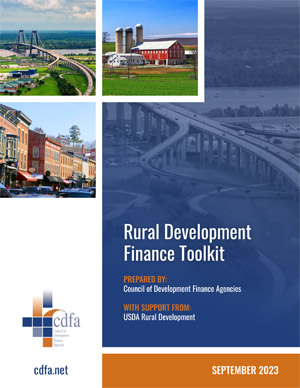CDFA Community Facilities Technical Assistance Program
-Direct Technical Assistance
CDFA provided technical assistance to four rural communities - Puna Region, Hawai’i; Lake City, South Carolina; Southern Pines, North Carolina; and Menominee County, Wisconsin. The selected communities received one on-site visit with a dedicated team of development finance experts to discuss how the USDA Community Facilities Program could be used, a roadmap outlining recommendations and potential next steps, and ongoing support to apply for the USDA’s Community Facilities Program. These communities were selected because they have a population of no more than 20,000 and have a Major Disaster Declaration from the Federal Emergency Management Agency (FEMA) for hurricanes or wildfires in 2018 or floods or tornadoes in 2019. They also had a local project eligible for the USDA Community Facilities Program.
Roadmap Reports
Toolkit
 Rural Development Finance Toolkit
Rural Development Finance ToolkitThe Rural Development Finance Toolkit provides rural communities with an easy-to-use, best practices resource on development finance tools. The toolkit offers an overview of the tools in the development finance toolbox -- such as bonds, tax increment finance, tax credits, and revolving loan funds -- and how they can direct and attract capital to rural businesses and projects. This toolkit features comprehensive case studies to provide recent project and program examples of how tools can be implemented to spur growth and resiliency in rural communities. By understanding the development finance toolbox, economic development professionals can increase public and private financing opportunities for the rural communities they serve.
-Rural Development Webinars
The CDFA Rural Development Finance Webinar Series is a three-part series providing information and best practices about financing tools and programs specifically targeted for rural communities. View the webinar recordings below:
View all webinars related to rural development
-Rural Development Resources
Rural Development Finance Resource Center
The Rural Development Finance Resource Center is a searchable online tool available on the CDFA website to learn about rural development finance programs at the federal, state, and local levels, as well as resources and best practices from communities.
Rural Finance Newsletter
The Rural Finance Newsletter is a periodic newsletter covering the latest headlines, developments, best practices and case studies related to development finance initiatives in rural communities.
-About the USDA Community Facilities Program
The Community Facilities Program is provided by USDA Rural Development to help support the financing and investment of essential facilities in rural communities. The Community Facilities Programs offer direct loans, loan guarantees and grants to develop or improve essential public services and facilities. These amenities help increase the competitiveness of rural communities in attracting and retaining businesses that provide employment and services for their residents.
Public bodies, non-profit organizations and federally recognized American Indian Tribes can use the funds to construct, expand or improve facilities that provide health care, education, public safety, and public services. Projects include fire and rescue stations, village and town halls, health care clinics, hospitals, adult and child care centers, assisted living facilities, rehabilitation centers, public buildings, schools, libraries, and many other community-based initiatives. Financing may also cover the costs for land acquisition, professional fees, and purchase of equipment. These facilities not only improve the basic quality of life but assist in the development and sustainability of rural America.
Using the Community Facilities Program
The Community Facilities Program provides affordable funding to develop essential community facilities, which is a facility that provides an essential service to the local community for the orderly development of the community. It must carry out a function customarily provided by a local unit of government. The facility must be located in a rural area with a population of no more than 20,000 and primarily serve rural residents. The facility must be operated on a nonprofit basis and does not include private affairs, commercial, or business undertakings (except for limited authority for industrial parks).
Eligible borrowers include:
- Public bodies
- Community-based nonprofit corporations
- Federally recognized Tribes
Funds can be used to purchase, construct, and/or improve essential community facilities, purchase equipment and pay related project expenses. Examples of essential community facilities include:
- Healthcare facilities such as hospitals, medical clinics, dental clinics, nursing homes, assisted living facilities, or facilities that provide for the prevention, treatment, and recovery of substance misuse disorders.
- Public facilities such as townhalls, courthouses, airport hangers, bridges, port authorities, or street improvements.
- Community support services such as child care centers, adult daycare, homeless shelters, community centers, or transitional housing.
- Public safety services such as fire departments, police stations, prisons, police vehicles, fire trucks, public works vehicles or equipment.
- Educational services such as schools, colleges and universities, community colleges, charter schools, vocational and technical schools, dormitories, museums, or libraries.
- Local food systems such as community gardens, food pantries, community kitchens, foodbanks, food hubs, or greenhouses.
- E-Connectivity end-user equipment to include distance learning equipment, telemedicine equipment, and health information technology equipment as well as internal wiring and publicly available Wi-Fi capability within a facility.
For a complete list of eligible loan purposes, see 7 CFR, Part 1942.17(d).
Additional Resources
USDA Community Facilities Programs
Community Facilities Fact Sheet
Community Facilities Infrastructure Toolkit
Community Facilities Guidance Book for Applicants
Community Facilities Location Policy